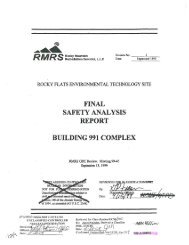silo 3 - U.S. Department of Energy
silo 3 - U.S. Department of Energy
silo 3 - U.S. Department of Energy
You also want an ePaper? Increase the reach of your titles
YUMPU automatically turns print PDFs into web optimized ePapers that Google loves.
.<br />
1<br />
2<br />
- 3<br />
4<br />
5<br />
6<br />
7<br />
8<br />
9<br />
10<br />
11<br />
12<br />
13<br />
14<br />
15<br />
16<br />
17<br />
18<br />
19<br />
I 20<br />
21<br />
22<br />
23<br />
24<br />
25<br />
26<br />
27<br />
28<br />
29<br />
30<br />
31<br />
32<br />
33<br />
34<br />
35<br />
36<br />
37<br />
38<br />
Silos Project Environmental Monitoring Plan<br />
40000-PL-0010<br />
August 29, 2002<br />
~ -- -- - - - - __ ---4- 'n * 6.-9- __<br />
0<br />
To better monitor radon levels in the K-65 area, five radon monitoring locations were added<br />
to the existing IEMP radon network in 2000. The monitors currently provide additional<br />
monitoring <strong>of</strong> radon levels in the vicinity <strong>of</strong> the <strong>silo</strong>s and will continue to do so during the Silo<br />
3 and AWR projects and subsequent operations for the Silos 1 and 2 material. The locations<br />
and designations for the monitors are:<br />
0<br />
0<br />
0<br />
0<br />
0<br />
North <strong>of</strong> Silo 2 at the K-65 exclusion fence, designated KNO.<br />
South <strong>of</strong> Silo 1 near the new south camera tower, designated KSO.<br />
East <strong>of</strong> Silo 4 and in the prevailing wind direction from Silo 3, designated LP2.<br />
East <strong>of</strong> the <strong>silo</strong> project construction area near Trailer #117, designated T117.<br />
An additional station was selected on the FEMP's west fenceline-to supplement the<br />
established IEMP monitoring network. The monitor (PR-1) is co-located with the WPTH-2<br />
*<br />
air particulafe monitor, on the western perimeter <strong>of</strong> the facility.<br />
The detail <strong>of</strong> the OU4 radon monitoring locations is shown on Dwg. 94X-5500-SK-5527<br />
(Attachment A). The map <strong>of</strong> the entire IEMP radon monitoring network is shown Attachment<br />
B. In order to accommodate construction activities, it may be necessary to re-locate radon<br />
monitors. Changes in monitoring locations will be documented and reviewed through the<br />
Design Change Notice (DCN) process.<br />
Real-time data from selected fenceline and <strong>silo</strong>s area monitors is available via a secure Internet<br />
address (the IEMP Data Information Site). The data will include the date and time <strong>of</strong> the most<br />
recent transmission, location, and latest radon concentration. This data is sent from the<br />
monitoring instrumentation without review or validation. Data review and validation will be<br />
conducted in a manner consistent with the current methods used under the IEMP radon<br />
monitoring program. Monthly radon summary data will also be posted to the IEMP Data<br />
Information Site after quarterly data quality reviews are completed.<br />
3.1.4 Project-Specific Air Particulate Monitoring Program<br />
The IEMP air particulate monitoring program, which is based on air monitors located at the<br />
FEMP's perimeter fenceline, provides early warning feedback regarding the cumulative sitewide<br />
effectiveness <strong>of</strong> all remediation project emission controls. The OU4 project-specific air<br />
particulate monitoring program will provide data that confirms the performance <strong>of</strong> the projects'<br />
emissions controls. In addition to providing confirmatory data, the monitoring program will also<br />
provide data to quantify the nature and extent <strong>of</strong> releases from the projects in the event <strong>of</strong> an<br />
upset condition. The program consists <strong>of</strong> four high-volume particulate air samplers that are<br />
co-located with the radon monitors at the Bio-surge lagoon, LP2, T117, and KNW-A locations<br />
shown on Attachment A. These samplers maintain a consistent air sample flow rate between<br />
40 and 50 cubic feet per minute through an 8 by 10-inch filter. In order to accommodate<br />
QOWS8<br />
4 <strong>of</strong> 7
















